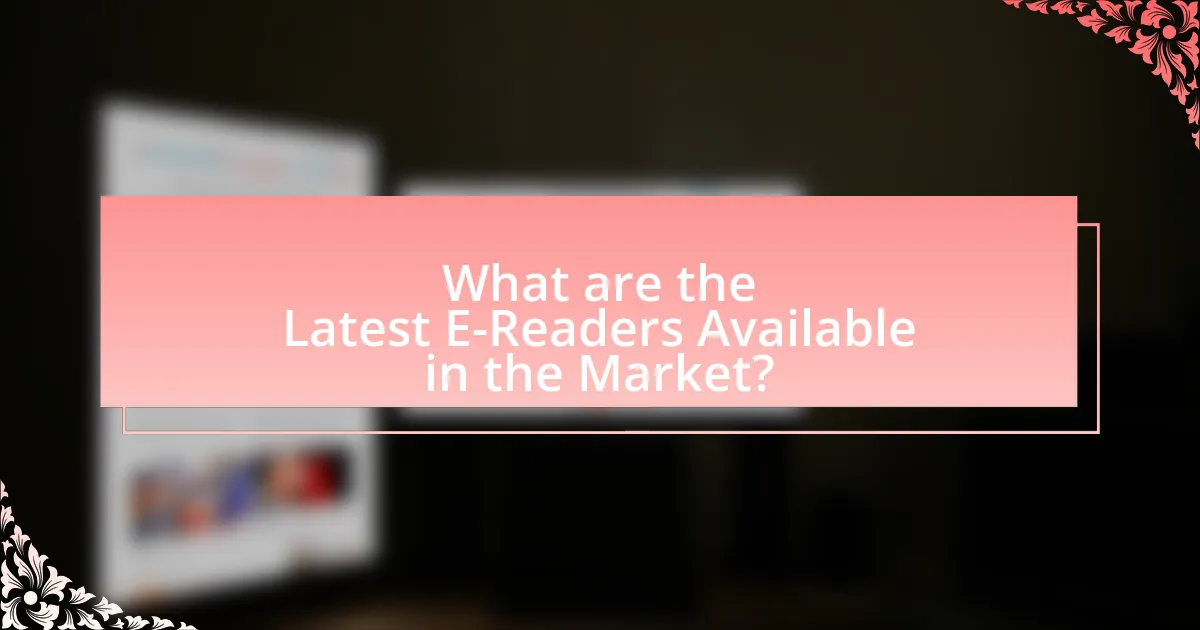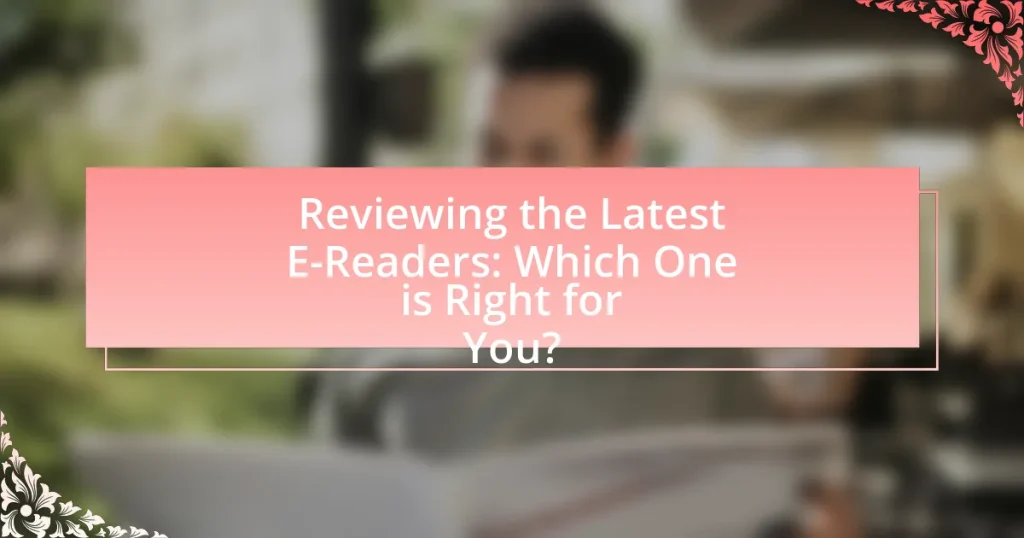The article reviews the latest e-readers available in the market, including the Amazon Kindle Oasis (2023), Kobo Clara 2E, and Barnes & Noble Nook GlowLight 4, highlighting their unique features and advancements in technology. It compares these devices based on display technologies, battery life, charging options, and pricing, while also addressing budget-friendly alternatives that maintain quality. Key factors influencing e-reader selection, such as screen size, resolution, storage options, and accessibility features, are discussed to help readers determine which e-reader best suits their individual preferences and reading habits. The article emphasizes the importance of understanding these aspects to enhance the overall reading experience.

What are the Latest E-Readers Available in the Market?
The latest e-readers available in the market include the Amazon Kindle Oasis (2023), Kobo Clara 2E, and the Barnes & Noble Nook GlowLight 4. The Amazon Kindle Oasis features a 7-inch display with adjustable warm light and waterproof capabilities, making it suitable for reading in various environments. The Kobo Clara 2E offers a 6-inch screen, ComfortLight PRO technology, and is made from recycled materials, appealing to eco-conscious consumers. The Barnes & Noble Nook GlowLight 4 has a 6-inch display with a sleek design and a long battery life, catering to users who prioritize portability and convenience. These devices reflect the latest advancements in e-reader technology, focusing on user experience and sustainability.
How do the latest e-readers compare in terms of features?
The latest e-readers, such as the Amazon Kindle Oasis, Kobo Libra 2, and Barnes & Noble Nook GlowLight 4, compare significantly in features, with each offering unique advantages. The Kindle Oasis features a 7-inch display with adjustable warm light and waterproofing, making it ideal for reading in various environments. The Kobo Libra 2 also has a 7-inch screen, supports a wider range of file formats, and includes ComfortLight for customizable brightness. The Nook GlowLight 4 offers a 6-inch display, a comfortable design, and a long battery life, appealing to users who prioritize portability. These differences highlight how each device caters to specific reading preferences and environments, allowing consumers to choose based on their individual needs.
What display technologies are used in the latest e-readers?
The latest e-readers primarily utilize E Ink technology, specifically E Ink Carta and E Ink Kaleido. E Ink Carta offers improved contrast and faster refresh rates, enhancing the reading experience by mimicking the appearance of printed paper. E Ink Kaleido introduces color capabilities, allowing for a wider range of content display while maintaining low power consumption. These technologies are widely adopted due to their ability to provide a comfortable reading experience in various lighting conditions, as well as their energy efficiency, which extends battery life significantly.
How do battery life and charging options vary among models?
Battery life and charging options vary significantly among e-reader models, with some offering weeks of usage on a single charge while others may require more frequent recharging. For instance, the Amazon Kindle Paperwhite boasts a battery life of up to 10 weeks, while the Kobo Clara HD provides around 7 weeks, both depending on usage patterns such as brightness settings and wireless connectivity. Charging options also differ; many models, like the Kindle Oasis, utilize a proprietary charging cable, while others, such as the Nook GlowLight 3, support standard USB-C charging, allowing for more versatile charging solutions. This variation in battery life and charging methods reflects the manufacturers’ design choices aimed at enhancing user convenience and reading experience.
What are the price ranges for the latest e-readers?
The price ranges for the latest e-readers typically fall between $100 and $400. For instance, entry-level models like the Amazon Kindle start around $100, while premium options such as the Kindle Oasis can reach up to $300. Additionally, specialized e-readers with advanced features, like the Kobo Elipsa, can be priced around $400. These price points reflect the varying features and capabilities offered by different models in the market.
What factors influence the pricing of e-readers?
The pricing of e-readers is influenced by several key factors, including brand reputation, technological features, display quality, storage capacity, and additional functionalities. Brand reputation plays a significant role, as established brands like Amazon and Kobo often command higher prices due to consumer trust and perceived quality. Technological features, such as touchscreen capabilities, waterproofing, and built-in lighting, also affect pricing; e-readers with advanced features typically cost more. Display quality, measured in resolution and screen type, impacts user experience and can lead to higher prices for models with superior displays. Storage capacity is another factor, as e-readers with larger storage options allow users to store more content, often resulting in increased costs. Lastly, additional functionalities, such as access to exclusive content or integration with other devices, can further influence the pricing structure of e-readers.
Are there budget-friendly options that still offer great features?
Yes, there are budget-friendly e-reader options that still offer great features. For instance, the Amazon Kindle (basic model) provides essential functionalities such as a glare-free display, adjustable front light, and access to a vast library of e-books at a competitive price point of around $90. Additionally, the Kobo Clara 2E, priced similarly, includes features like waterproofing and a comfortable reading experience with its high-resolution display. These models demonstrate that consumers can find quality e-readers with desirable features without exceeding a modest budget.

What Key Features Should You Consider When Choosing an E-Reader?
When choosing an e-reader, key features to consider include screen quality, battery life, storage capacity, and ecosystem compatibility. Screen quality, particularly e-ink technology, provides a paper-like reading experience, reducing eye strain and enhancing readability in various lighting conditions. Battery life is crucial, as many e-readers can last weeks on a single charge, making them convenient for travel. Storage capacity is important for holding a large library of books; most e-readers offer anywhere from 8GB to 32GB, accommodating thousands of titles. Ecosystem compatibility refers to the ability to access and purchase books from various platforms, with some e-readers being tied to specific stores, which can limit options. These features collectively determine the overall usability and satisfaction of the e-reader experience.
How does screen size impact your reading experience?
Screen size significantly impacts the reading experience by influencing text visibility, comfort, and engagement. Larger screens provide more space for text, reducing the need for frequent scrolling or zooming, which enhances readability and allows for a more immersive experience. Research indicates that users prefer screens around 7 to 10 inches for e-readers, as this size balances portability with readability, allowing for comfortable reading sessions without straining the eyes. Additionally, a study published in the Journal of Usability Studies found that larger screens improve user satisfaction and comprehension, as they can display more content at once, facilitating easier navigation through texts.
What are the advantages of larger screens versus smaller ones?
Larger screens provide enhanced readability and a more immersive experience compared to smaller screens. The increased screen size allows for larger text and images, reducing eye strain and improving comprehension, especially for lengthy reading materials. Research indicates that users often prefer larger displays for activities such as reading e-books or viewing documents, as they can view more content at once without scrolling. Additionally, larger screens facilitate multitasking by allowing users to have multiple applications or documents open simultaneously, which is particularly beneficial for productivity tasks.
How does screen resolution affect readability?
Screen resolution significantly affects readability by determining the clarity and sharpness of text displayed on screens. Higher screen resolutions, such as 300 PPI (pixels per inch) or more, provide finer detail, making text easier to read without straining the eyes. For instance, studies show that displays with resolutions above 200 PPI can enhance reading speed and comprehension, as they reduce pixelation and improve font rendering. Conversely, lower resolutions can lead to blurred text and visual fatigue, negatively impacting the reading experience.
What storage options are available in e-readers?
E-readers typically offer two main storage options: internal storage and expandable storage via microSD cards. Internal storage capacities generally range from 4GB to 32GB, allowing users to store thousands of eBooks, with some models supporting cloud storage for additional access. Expandable storage through microSD cards is available in select e-reader models, enabling users to increase their storage capacity as needed. This flexibility in storage options ensures that users can manage their eBook libraries effectively.
How much storage do you really need for your reading habits?
For typical reading habits, 8 to 32 GB of storage is generally sufficient. This range accommodates thousands of eBooks, as an average eBook file size is around 1 MB. For instance, with 32 GB, a user can store approximately 30,000 eBooks, which exceeds the needs of most avid readers. Additionally, if a reader frequently downloads audiobooks or magazines, opting for 32 GB or more is advisable, as these files can be significantly larger, averaging 100 MB or more per audiobook.
What are the differences between cloud storage and local storage?
Cloud storage and local storage differ primarily in their accessibility and management. Cloud storage allows users to access data over the internet from any device, while local storage confines data to a specific device, such as a computer or external hard drive. According to a 2021 report by Statista, 67% of businesses utilize cloud storage solutions for their flexibility and scalability, whereas local storage is often limited by physical space and hardware constraints. Additionally, cloud storage typically offers automatic backups and remote access, enhancing data security and convenience, while local storage requires manual backups and is vulnerable to physical damage or loss.

How Do Different E-Readers Cater to Various Reading Preferences?
Different e-readers cater to various reading preferences by offering features tailored to individual needs, such as screen technology, lighting options, and content accessibility. For instance, devices like the Amazon Kindle Paperwhite utilize E Ink technology, which mimics the appearance of paper and reduces eye strain, appealing to users who prefer a traditional reading experience. In contrast, tablets like the Apple iPad provide vibrant color displays and multimedia capabilities, attracting readers who enjoy interactive content and diverse formats. Additionally, some e-readers, such as the Kobo Clara HD, offer adjustable front lighting and customizable font sizes, accommodating users with specific visual preferences. These features demonstrate how e-readers are designed to meet the diverse demands of readers, enhancing their overall reading experience.
What types of content can you read on e-readers?
E-readers can display various types of content, including eBooks, magazines, newspapers, and PDFs. The primary function of e-readers is to provide a digital platform for reading text-based content, which is often available in formats such as EPUB and MOBI for eBooks. Additionally, many e-readers support subscription services that allow users to access a wide range of magazines and newspapers digitally. The ability to read PDFs is also a common feature, enabling users to view documents in their original format. This versatility makes e-readers suitable for diverse reading preferences and needs.
How do e-readers support different file formats?
E-readers support different file formats by incorporating software that can decode and display various types of digital content. Most e-readers are designed to handle popular formats such as EPUB, PDF, MOBI, and AZW, allowing users to access a wide range of e-books and documents. For instance, Amazon Kindle devices primarily support AZW and MOBI formats, while devices like the Kobo and Nook support EPUB and PDF formats. This compatibility is achieved through built-in applications or firmware that interpret the file structure and render the text and images appropriately, ensuring a seamless reading experience across diverse content types.
What are the benefits of accessing libraries and subscriptions on e-readers?
Accessing libraries and subscriptions on e-readers provides users with a vast selection of reading materials at minimal or no cost. E-readers enable users to borrow e-books from public libraries, often allowing access to thousands of titles without the need for physical storage. Additionally, subscription services like Kindle Unlimited or Scribd offer unlimited access to a wide range of books, audiobooks, and magazines for a monthly fee, enhancing the reading experience. According to a 2021 survey by the Pew Research Center, 27% of Americans reported using library e-book services, highlighting the growing trend of digital borrowing. This accessibility not only promotes reading but also supports diverse literary choices and encourages lifelong learning.
How do e-readers enhance the reading experience for different users?
E-readers enhance the reading experience for different users by providing customizable features that cater to individual preferences and needs. For instance, users can adjust font size, background color, and brightness, which improves readability for those with visual impairments or specific reading preferences. Additionally, e-readers often include built-in dictionaries and note-taking capabilities, allowing users to engage more deeply with the text. Research indicates that e-readers can improve reading comprehension and retention, particularly among younger readers, due to interactive features that facilitate engagement. Furthermore, the portability of e-readers enables users to carry multiple books in one device, making reading more accessible in various environments.
What features are beneficial for casual readers versus avid readers?
Casual readers benefit from features that enhance convenience and accessibility, while avid readers require advanced functionalities that support extensive reading habits. Casual readers often prefer lightweight devices with long battery life and simple interfaces, allowing for easy navigation and quick access to content. In contrast, avid readers value features such as customizable reading settings, extensive storage capacity for large libraries, and advanced annotation tools that facilitate deeper engagement with texts. Research indicates that 70% of avid readers prioritize features like adjustable font sizes and backlighting, which enhance their reading experience over extended periods.
How do accessibility features improve usability for diverse readers?
Accessibility features significantly enhance usability for diverse readers by providing tailored options that accommodate various needs, such as visual impairments, learning disabilities, and different reading preferences. For instance, features like text-to-speech, adjustable font sizes, and high-contrast modes allow individuals with visual impairments to engage with content more effectively. Research indicates that approximately 15% of the global population experiences some form of disability, highlighting the importance of these features in making reading materials inclusive. Furthermore, studies show that e-readers with accessibility options can improve comprehension and retention for users with learning disabilities, thereby fostering a more equitable reading experience.
What are the best practices for choosing the right e-reader for you?
To choose the right e-reader, prioritize your reading habits, budget, and desired features. Assess whether you prefer a device with a larger screen for reading PDFs or a compact model for portability. Consider battery life, as some e-readers can last weeks on a single charge, while others may require more frequent charging. Evaluate the ecosystem of available books and compatibility with formats, as some e-readers support more file types than others. Additionally, check for features like adjustable lighting for reading in various environments and waterproofing if you plan to read near water. Research indicates that user satisfaction often correlates with these factors, as a survey by the Pew Research Center found that 27% of e-reader owners cite ease of use as a primary reason for their choice.

